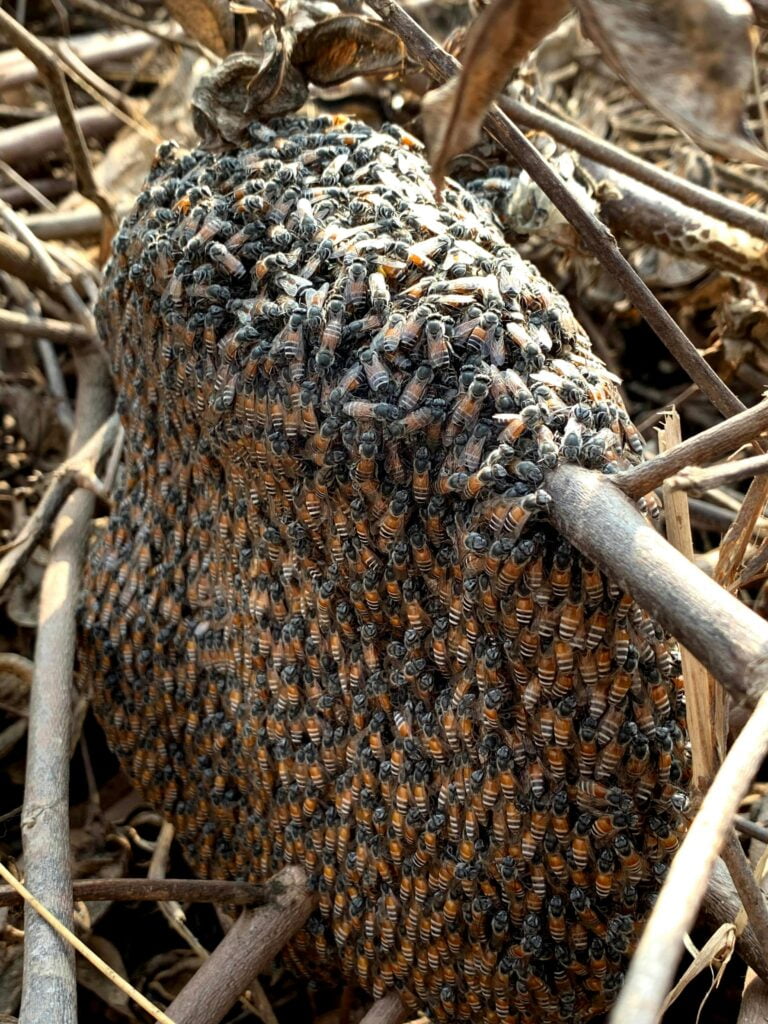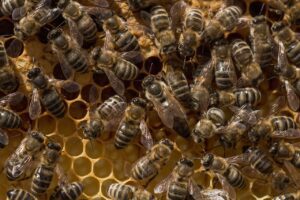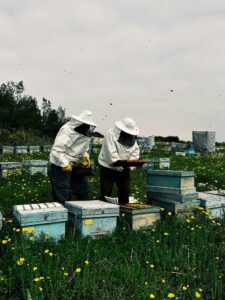Swarm prevention is a crucial aspect of successful beekeeping, ensuring that your colonies remain productive and healthy throughout the season. In this comprehensive guide, we’ll delve into 12 expert tips for effective swarm prevention, focusing on key practices like regular hive inspection, proper hive management, and addressing issues with queen cells. By following these strategies, you’ll enhance your beehive inspection routine and maintain a thriving apiary. Whether you’re a seasoned beekeeper or just starting, these tips will help you keep your colonies in check and minimize the risk of swarming.

Table of Contents
1. Regular Hive Inspections

Importance of Consistent Hive Monitoring
Conducting hive inspections every 7-10 days during the swarming season is crucial for preventing swarms. Regular inspections allow you to monitor the colony’s condition, identify any issues early, and take corrective action. By keeping a close eye on your hives, you can detect the presence of queen cells, which are a strong indicator that the colony is preparing to swarm. Additionally, regular inspections help you manage the hive’s resources, ensuring the bees have enough space and food. This proactive approach to hive management helps maintain a stable and productive colony.
- Look for signs of overcrowding and congestion.
- Check for queen cells and remove them if found.
- Monitor the health and activity levels of the colony during each beehive inspection.
Identifying Early Signs of Swarming
During hive inspections, be vigilant for early signs of swarming. Bees may start building queen cells or reducing the queen’s egg-laying space. Look for increased drone production and changes in bee behavior, such as clustering near the hive entrance. These signs indicate the colony’s readiness to swarm, allowing you to take preventive measures promptly. Read more at 6 Ways Queen Bees Influence Hive Behavior and Productivity.
- Observe for increased drone numbers and queen cells.
- Note changes in brood patterns and space usage.
- Act quickly if early swarming signs are detected.
2. Provide Adequate Space
Expanding Your Hive to Prevent Overcrowding
Ensuring your bees have enough space is a key factor in swarm prevention. Overcrowding can lead to increased stress and a higher likelihood of swarming. Adding supers or expanding the brood nest provides the bees with more room to store honey and raise brood. This not only reduces the risk of swarming but also enhances the colony’s productivity. Be proactive in providing space before the bees become too crowded to optimize your hive management.
- Add additional supers or brood boxes as needed.
- Monitor the growth of the colony and anticipate their space needs.
- Use drawn combs to encourage the bees to move into new areas quickly.
Using Supers Effectively
Adding supers is a practical way to give bees more space. Ensure you add supers in a timely manner before the colony becomes congested. Place supers with drawn comb to make it easier for bees to start working in the new space. Properly managed supers help reduce swarming impulses by alleviating overcrowding.
- Add supers with drawn comb to facilitate quick occupancy.
- Place supers early to prevent congestion.
- Rotate supers based on hive needs and nectar flow.
3. Control Hive Temperature
Managing Ventilation and Temperature
Maintaining proper hive ventilation and temperature is essential for swarm prevention. Bees may become agitated and prone to swarming if the hive becomes too hot. Ensure that your hives have adequate airflow by using screened bottom boards or providing ventilation holes. Positioning your hives in a shaded area during hot weather can also help keep the temperature down. By controlling the hive environment, you can reduce the bees’ inclination to swarm due to heat stress.
- Install ventilation aids such as screened bottom boards.
- Provide shading for hives exposed to direct sunlight.
- Ensure the hive entrance is clear to promote airflow.
Shading and Insulating Hives
During hot weather, provide shading to keep hives cool. Use hive stands or covers to protect hives from direct sunlight. In colder weather, insulate the hives to maintain a stable internal temperature. Proper shading and insulation prevent temperature extremes that can stress bees and trigger swarming behavior.
- Use hive covers or stands for shading.
- Insulate hives during cold weather. Find more at Winter Bee Hive Wraps: 6 Step Beginner Guide to Protect Bees.
- Monitor temperature changes and adjust shading or insulation as needed.
4. Requeen Regularly
Successfully Introducing a New Queen – 12 Key Strategies
Benefits of Introducing a Young Queen
Requeening your hives every one to two years with a young, productive queen can significantly reduce the swarming impulse. Young queens are more vigorous and less likely to lead the colony into swarming. Requeening helps maintain a strong, healthy colony and ensures consistent brood production. This practice also allows you to select queens with desirable traits, such as gentleness and disease resistance, improving the overall quality of your bees.
- Schedule requeening during a low-stress period for the bees. You can learn to create a schedule at 12-Month Beekeeping Schedule: Essential Roadmap to Success.
- Choose queens from reputable breeders with strong genetics.
- Monitor the integration of the new queen to ensure acceptance.
Timing and Methods for Requeening
The best time to requeen is during early spring or late summer when the bees are less stressed. There are different methods to introduce a new queen, such as using a queen cage or a push-in cage. Ensure the old queen is removed and the new queen is introduced gradually to increase the chances of acceptance.
- Requeen in early spring or late summer.
- Use queen cages or push-in cages for introduction.
- Gradually introduce the new queen to the colony.
5. Split Strong Colonies
How to Successfully Split a Hive
Splitting strong colonies is an effective method for preventing swarming. By dividing a large, populous colony into two smaller ones, you reduce congestion and provide more space for the bees to thrive. To perform a split, move frames of brood, bees, and resources into a new hive box, ensuring each split has a balanced population and adequate resources. This not only prevents swarming but also allows you to increase your hive numbers and improve your beekeeping tips arsenal.
- Identify strong colonies that are candidates for splitting.
- Ensure each new hive has a queen or introduce a new queen.
- Provide sufficient resources for both splits to thrive.
Timing and Techniques for Splitting
The best time to split a hive is during early spring or late summer when resources are abundant, and the bees can recover quickly. Use the walk-away split method or the nucleus split method depending on your colony’s condition and your goals. Ensure each split has a balanced population of workers, brood, and food stores.
- Split hives in early spring or late summer.
- Use walk-away or nucleus split methods.
- Balance worker population, brood, and food stores in each split.
6. Remove Queen Cells

Disrupting the Swarming Process
During hive inspections, removing queen cells is a crucial step in preventing swarming. Queen cells are a clear sign that the colony is preparing to swarm. By removing these cells, you disrupt the swarming process and keep the bees focused on their current queen. It’s important to be thorough and remove all queen cells to prevent the bees from raising a new queen and initiating a swarm.
- Identify and remove queen cells during each inspection.
- Check for queen cups and potential queen cells regularly.
- Ensure the colony remains queenright and productive.
- 10 Tips for Beekeepers Locating the Queen Bee During Hive Inspections
Recognizing Different Types of Queen Cells

There are three types of queen cells: swarm cells, supersedure cells, and emergency cells. Swarm cells are typically found on the edges of frames, supersedure cells in the middle, and emergency cells scattered throughout. Knowing the differences helps you determine the colony’s intentions and take appropriate action.
- Swarm cells are usually on frame edges.
- Supersedure cells are found in the middle of the frame.
- Emergency cells are scattered throughout the hive.
7. Feed Appropriately
Choosing Bee Feeders: 10 Proven Tips and How to Use Them
Balancing Feeding to Avoid Overgrowth
Providing the right amount of food to your bees is essential for maintaining colony balance. Overfeeding can lead to rapid population growth and increased swarming behavior. Ensure your bees have sufficient resources, especially during periods of nectar dearth, but avoid excessive feeding that could encourage overcrowding. Balanced feeding supports a healthy, stable colony without triggering the swarming impulse.
- Monitor the colony’s food stores and feed as needed.
- Avoid overfeeding during times of abundant natural forage.
- Use feeders that allow controlled, gradual feeding.
Types of Feeders and Feeding Methods
There are various types of feeders, such as entrance feeders, top feeders, and division board feeders. Each type has its advantages and is suited to different situations. Choose the right feeder based on your hive’s needs and the season. Gradual and controlled feeding helps maintain colony stability and reduces the risk of swarming.
- Use entrance feeders for easy access.
- Top feeders provide large amounts of syrup.
- Division board feeders are placed inside the hive.
8. Rotate Frames
Maintaining a Healthy Brood Nest
Regularly rotating old frames out of the hive and replacing them with new ones is vital for maintaining a healthy brood nest. This practice helps prevent the buildup of diseases and pests that can stress the colony and lead to swarming. By keeping the brood nest clean and well-maintained, you support the overall health and stability of the hive, reducing the likelihood of swarming.
- Replace old, dark combs with fresh, new frames.
- Rotate frames gradually to avoid disrupting the colony too much at once.
- Inspect frames for signs of disease or pest infestations during each beehive inspection.
Techniques for Frame Rotation
Rotate frames by moving old frames to the outer edges of the brood nest and replacing them with new frames in the center. Do this gradually to avoid stressing the colony. Regular frame rotation not only prevents swarming but also promotes a healthy hive environment by reducing disease and pest pressure.
- Move old frames to the outer edges.
- Replace central frames with new ones.
- Rotate frames gradually to minimize colony disruption.
9. Equalize Colonies
Balancing Hive Strength
Equalizing colonies by moving frames of brood or bees from stronger hives to weaker ones helps maintain balance and prevent any single hive from becoming overcrowded. This practice ensures that all your colonies have a similar population size and resource availability. By preventing any one colony from becoming too strong, you reduce the risk of swarming and promote a more uniform beekeeping operation.
- Transfer frames of brood or bees to weaker colonies as needed.
- Monitor the strength of all your hives regularly.
- Use this method to balance resources and population across your apiary.
Methods for Equalizing Colonies
There are several methods to equalize colonies, such as exchanging frames of brood or bees, moving entire frames of capped brood, or transferring resources like honey and pollen. This helps distribute the population evenly among your hives and prevents any single colony from becoming too strong, reducing the risk of swarming.
- Exchange frames of capped brood to equalize colony strength.
- Transfer bees and resources between hives to balance populations.
- Monitor colony conditions regularly to maintain balance.
10. Use Queen Excluders Wisely
Managing Queen Movement Without Restriction
Queen excluders can be a useful tool, but they must be used wisely to prevent congestion and swarming. Ensure that queen excluders do not overly restrict the queen’s movement, which can lead to overcrowding in the brood nest. Proper use of queen excluders helps manage the hive’s space without hindering the colony’s natural behavior, thus reducing the risk of swarming.
- Position queen excluders to allow adequate space for the queen to lay eggs.
- Monitor the brood nest for signs of congestion.
- Adjust or remove excluders if they are causing problems.
- 10 Tips for Choosing the Right Queen Excluder for Your Hive
Alternatives to Queen Excluders
If you find that queen excluders are causing issues, consider alternative methods for managing the queen’s movement. One option is to create a double brood chamber, giving the queen more space to lay eggs. This can help reduce congestion and the likelihood of swarming without the need for excluders.
- Use a double brood chamber for additional laying space.
- Monitor the brood nest and adjust management techniques as needed.
- Evaluate the effectiveness of alternatives to queen excluders.
11. Maintain a Productive Queen
Ensuring Queen Health and Productivity
Keeping your queen healthy and productive is essential for preventing swarming. A well-functioning queen maintains a strong brood pattern and reduces the colony’s inclination to swarm. Ensure the queen has enough space to lay eggs and replace her if she becomes less productive. A productive queen supports a stable and thriving colony.
- Monitor the queen’s laying pattern and brood quality.
- Provide ample space for the queen to lay eggs.
- Replace the queen if her productivity declines significantly.
Signs of a Declining Queen
Recognize signs of a declining queen, such as irregular brood patterns, decreased egg laying, and increased drone production. Here are 5 Essential Roles of Honey Bee Drones Every Beekeeper Needs to Know. Identifying these signs early allows you to replace the queen before the colony becomes stressed and more likely to swarm.
- Look for irregular brood patterns and spotty egg laying.
- Monitor for increased drone production.
- Act promptly to replace a declining queen.
12. Monitor and Manage Pests and Diseases
Keeping Your Colony Healthy
Regularly checking for and treating pests and diseases is crucial for maintaining a healthy colony and preventing swarming. Pests and diseases can stress the bees, making them more likely to swarm. By keeping your hives clean and addressing any health issues promptly, you support the colony’s stability and reduce the risk of swarming.
- Inspect hives for signs of pests such as Varroa mites.
- Implement integrated pest management strategies.
- Treat diseases promptly to prevent colony stress and swarming.
Integrated Pest Management Strategies
Implement integrated pest management (IPM) strategies to keep your hives healthy. IPM combines various methods, such as mechanical controls, biological treatments, and chemical interventions, to manage pests and diseases effectively. This approach helps maintain colony health and reduces the likelihood of swarming.
- Use mechanical controls like screened bottom boards for pest management.
- Apply biological treatments such as beneficial nematodes or fungi.
- Use chemical interventions as a last resort and follow guidelines carefully.
Additional Resources
USDA PROGRAMS AND RESOURCES TO SUPPORT BEEKEEPERS
Conclusion
Effective swarm prevention is vital for maintaining the health and productivity of your beehives. By implementing these 12 tips, you’ll improve your hive management practices, streamline your hive inspection process, and address potential issues with queen cells before they escalate. Regular and thorough beehive inspections, combined with proactive swarm prevention strategies, will help ensure that your colonies stay strong and productive throughout the season. Embrace these practices to create a stable and thriving environment for your bees, reducing the likelihood of swarming and enhancing your beekeeping success.



